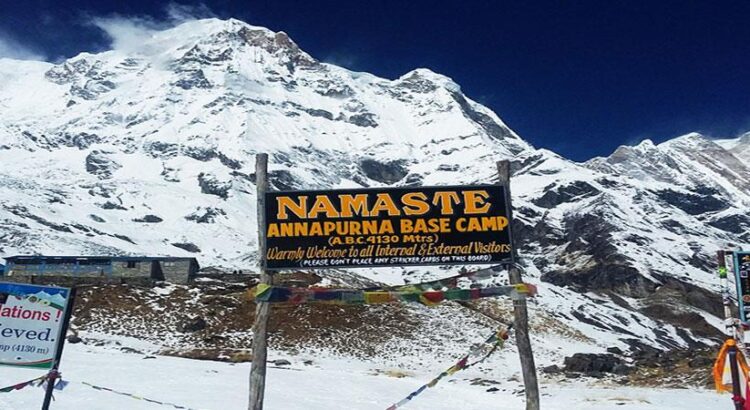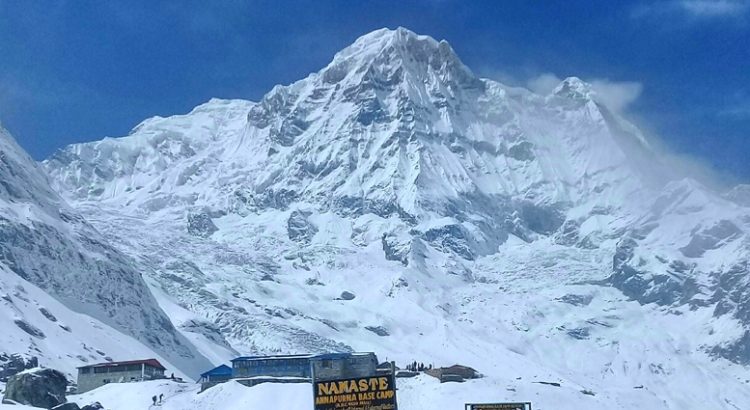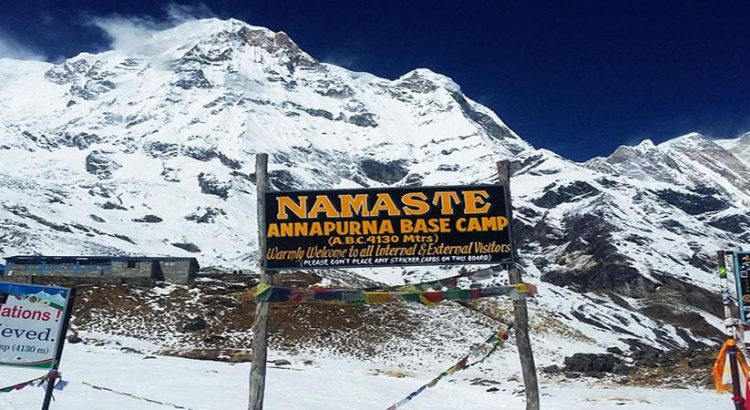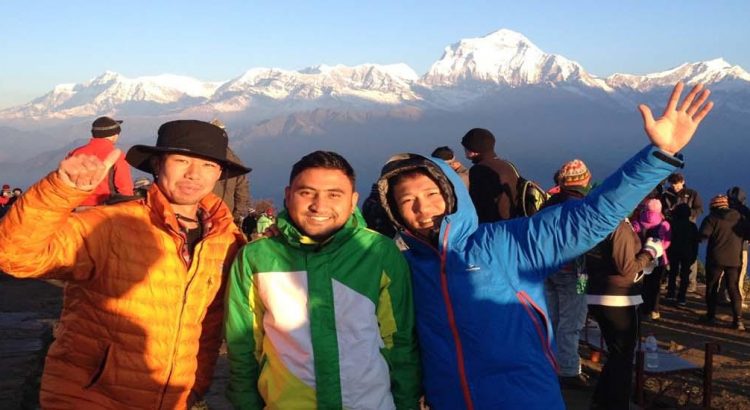Welcome to Nepal! Embark on an unforgettable adventure with our 12 Days Annapurna Base Camp Trek. This journey takes you through diverse landscapes, from lush green forests to rugged mountain trails. Begin in the vibrant city of Pokhara, then trek through traditional villages where friendly locals welcome you with warm hospitality. As you ascend, marvel at breathtaking views of snow-capped peaks like Annapurna and Machapuchare. Each day brings new experiences and challenges, culminating in reaching the base camp at 4,130 meters above sea level. Immerse yourself in the tranquility of the Himalayas and create memories that will last a lifetime. Join us for this incredible trek and discover the natural beauty of Nepal!
Introduction of Annapurna Base Camp Trek
The Annapurna Base Camp Trek is a renowned trekking adventure in Nepal that leads to the base of the majestic Annapurna massif. This trek offers a diverse range of landscapes, including lush forests, terraced fields, and high-altitude scenery, ultimately culminating at Annapurna Base Camp (4,130 meters). Trekkers experience rich cultural encounters in local villages along the way, with stunning views of Annapurna peaks and the iconic Machapuchare (Fishtail) mountain. The Annapurna Base Camp Trek is a must-do for nature enthusiasts seeking a rewarding Himalayan experience.
Trip Highlights of Annapurna Base Camp Trek
- Scenic drive from Kathmandu to Pokhara, a beautiful lakeside city
- Trek through diverse landscapes including lush forests, bamboo groves, and rhododendron forests
- Encounter local Gurung and Magar villages, experiencing their unique culture and hospitality
- Reach Machapuchare Base Camp and Annapurna Base Camp, surrounded by towering Himalayan peaks
- Stunning panoramic views of Annapurna South, Annapurna I, Hiunchuli, and other snow-capped mountains
- Relax in natural hot springs at Jhinu Danda
- Visit charming Gurung village of Ghandruk with traditional houses and mountain vistas
Why Choose Annapurna Base CampTrek?
Choosing the Annapurna Base Camp Trek offers a multitude of compelling reasons:
01. Scenic Diversity: Experience diverse landscapes ranging from lush forests and terraced fields to alpine meadows and snowy peaks.
02. Cultural Immersion: Encounter authentic local villages inhabited by Gurung and Magar communities, allowing for cultural exchanges and unique insights into traditional mountain life.
03. Spectacular Mountain Views: Witness breathtaking vistas of Annapurna massif, including Annapurna I, Machapuchare (Fishtail), and other prominent peaks.
04. Moderate Difficulty: Suitable for trekkers of various fitness levels, offering a manageable challenge with rewarding scenery.
05. Accessible Route: Starting from Pokhara, the trek is easily accessible and well-serviced with teahouses and facilities along the way.
06. Natural Hot Springs: Enjoy a rejuvenating dip in natural hot springs at Jhinu Danda, providing relaxation after days of trekking.
07. Safe and Established Route: The Annapurna Base Camp Trek is a popular and well-established route with clear paths and ample support infrastructure.
08. Seasonal Flexibility: Trekking is possible throughout the year, with the best seasons being spring (March to May) and autumn (September to November), offering favorable weather and clear mountain views.
Overall, the Annapurna Base Camp Trek is a rewarding adventure combining natural beauty, cultural experiences, and moderate trekking challenges, making it a top choice for trekkers seeking an unforgettable Himalayan journey.
Annapurna Base Camp Trek Itinerary
Day 01: Arrival in Kathmandu (1,400m)
Day 02: Flight/ Drive to Pokhara (822Meters), 25 min flight, 6 hour drive
Day 03: Drive to Nayapul and trek to Ulleri (1,960m), 2 hour drive and 4-5 hour trek
Day 04: Trek from Ulleri to Ghorepani (2,800m), 4-5 hour trek
Day 05: Morning hike to Poonhill (3,210m), Trek to Tadapani (2,630m), 5-6 hour trek
Day 06: Trek from Tadapani to Sinuwa (2,340m), 5-6 hours trek
Day 07: Trek from Sinuwa to Himalaya (3,000m), 5-6 hour trek
Day 08: Trek from Himalaya to Annapurna Base Camp (4,130m) via Machhapuchhare Base Camp (4,000m), 7-8 hour trek
Day 09: Return trek from ABC to Sinuwa (2,630m), 6-7 hour trek
Day 10: Trek from Sinuwa to Jhinu Danda (1,750m), 5-6 hour trek
Day 11: Trek from Jhinu to Nayapul and drive to Pokhara, 5-6 hour trek, 1-2 hour drive
Day 12: Return flight/drive to Kathmandu, Departure
Best Season for Annapurna Base Camp Trek
The best season for the Annapurna Base Camp Trek is during autumn (September to November) and spring (March to May). These months offer clear skies, stable weather conditions, and stunning mountain views. The temperatures are moderate, making trekking comfortable during the day with cool nights. Spring brings colorful rhododendron blooms along the trails, adding to the scenic beauty. Autumn, on the other hand, offers post-monsoon clarity with excellent visibility of the snow-capped peaks. Trekking during these seasons ensures an enjoyable and rewarding experience on the Annapurna Base Camp route.
Annapurna Base Camp Trek Difficulty
The Annapurna Base Camp Trek is generally considered to be of moderate difficulty. While it does involve ascending to altitudes above 4,000 meters, the trek does not require any technical climbing skills or equipment. However, trekkers should be prepared for long days of hiking, varying weather conditions, and some steep uphill sections. The trail is well-established, and there are teahouses along the route providing accommodation and meals, which makes logistics easier. With proper preparation, including physical conditioning and acclimatization, as well as a reasonable level of fitness, most trekkers can successfully complete the Annapurna Base Camp Trek and enjoy its breathtaking scenery and cultural experiences.
Accommodation Options on the Annapurna Base Camp Trek
During the Annapurna Base Camp Trek, accommodation options primarily consist of teahouses or guesthouses located in villages along the trail. Teahouses are basic but comfortable lodges offering rooms with twin beds or dormitory-style accommodations. The facilities are simple, with shared bathrooms (often squat toilets) and communal dining areas where meals are served. Most teahouses provide blankets, pillows, and basic amenities such as hot showers (for an additional cost) and charging outlets (sometimes for a fee). Some larger villages like Ghorepani and Chhomrong may have slightly more developed guesthouses with better amenities. It’s advisable to carry a sleeping bag for additional warmth and comfort, especially at higher elevations. Overall, teahouses provide a cozy and authentic mountain experience, and staying in these accommodations contributes to the local economy of the trekking region.
Meals Options on the Annapurna Base Camp Trek
On the Annapurna Base Camp Trek, meals are typically provided at the teahouses or guesthouses along the route. The meal options may vary slightly depending on the location and availability of ingredients, but most teahouses offer a menu with a range of Nepali and Western dishes. Common meal choices include:
01. Dal Bhat: A traditional Nepali dish consisting of rice (bhat), lentil soup (dal), seasonal vegetables, pickles, and sometimes meat (chicken or buffalo).
02. Noodles and Fried Rice: Varieties of noodle dishes (such as chowmein) and fried rice with vegetables or eggs are popular options.
03. Pasta and Pizza: Some teahouses offer pasta dishes like spaghetti or macaroni, as well as pizzas with basic toppings.
04. Soups: Warm soups like vegetable soup, tomato soup, or noodle soup are ideal for cold evenings at higher altitudes.
05. Breakfast Items: Breakfast choices typically include pancakes, porridge, eggs (boiled, fried, or omelette), toast, and Tibetan bread with jam or honey.
06. Beverages: Teahouses serve a variety of hot drinks including tea (black, milk, ginger, lemon), coffee, hot chocolate, and soft drinks.
Meals are hearty and filling, providing the necessary energy for trekking. It’s advisable to stick to vegetarian options or dishes with meat that are well-cooked to minimize the risk of foodborne illnesses. Keep in mind that food prices tend to increase as you ascend higher due to the logistical challenges of transportation. Overall, teahouse meals on the Annapurna Base Camp Trek offer a satisfying and convenient dining experience amidst the beautiful Himalayan landscapes.
Required Permits for the Annapurna Base Camp Trek
To undertake the Annapurna Base Camp Trek, you will need two main permits: the Annapurna Conservation Area Permit (ACAP) and the Trekkers’ Information Management System (TIMS) Card. The ACAP is mandatory for entry into the Annapurna Conservation Area, promoting environmental conservation and sustainable tourism. TIMS cards help authorities track trekkers and provide assistance during emergencies. Additional permits, such as the Restricted Area Permit, may be necessary if combining the trek with other trails. Ensure you obtain these permits from the Nepal Tourism Board office or authorized agencies before starting your trek.
Guides and Porters Service on the Annapurna Base Camp Trek
Guides and porters are valuable services to consider for the Annapurna Base Camp Trek, enhancing safety and enjoyment. Hiring a local guide provides navigation assistance, cultural insights, and ensures you stay on the designated trail. Guides also offer valuable knowledge about the region’s flora, fauna, and local customs. Porters can help carry your trekking gear, lightening your load and allowing you to focus on the trekking experience. Both guides and porters contribute to the local economy and are readily available through trekking agencies in Pokhara or Kathmandu. Engaging these services is optional but highly recommended for a smoother and more enriching trekking experience.
Transportation Services for Annapurna Base Camp Trek
Transportation services for the Annapurna Base Camp Trek typically involve the following:
Local Bus or Private Vehicle to Pokhara: The trek usually begins from Pokhara, a scenic lakeside city in Nepal. You can reach Pokhara from Kathmandu by taking a local bus (approximately 6-8 hours) or a private vehicle (4-6 hours) depending on your preference and budget.
Pokhara to Trek Starting Point (Nayapul or Phedi): From Pokhara, you’ll need transportation to the trek starting point, which is either Nayapul or Phedi depending on your chosen route. This can be arranged by local bus, private vehicle, or taxi.
Return Transportation from Trek End Point (Nayapul or Kimche): At the end of the trek, transportation will be needed to return from the trek end point (Nayapul or Kimche) back to Pokhara. This can also be arranged by local bus, private vehicle, or taxi.
Domestic Flights (Optional): For those seeking a quicker mode of transportation, domestic flights from Kathmandu to Pokhara are available, reducing travel time significantly. However, flights are weather-dependent and may be subject to delays or cancellations.
Local trekking agencies in Pokhara or Kathmandu can assist with arranging transportation services for the Annapurna Base Camp Trek, including transfers to and from the trek starting and ending points. It’s recommended to book transportation in advance to ensure availability and a smooth start to your trekking adventure.
Annapurna Base Camp Trek Cost
The cost of the Annapurna Base Camp Trek can vary depending on various factors including the duration of the trek, the level of service, and individual preferences. Here’s a breakdown of potential costs associated with the trek:
Permits: The Annapurna Conservation Area Permit (ACAP) and Trekkers’ Information Management System (TIMS) Card are essential permits that need to be purchased. The cost for these permits typically ranges from USD 30 to USD 50 per person, depending on nationality and season.
Transportation: This includes the cost of transportation from Kathmandu (or Pokhara) to the trek starting point (Nayapul or Phedi) and back. The cost of bus tickets or private transfers can range from USD 10 to USD 30 per person each way.
Guide and Porter Fees: Hiring a guide and/or porter is optional but recommended for safety and convenience. The cost for a guide usually ranges from USD 20 to USD 30 per day, and for a porter, it ranges from USD 15 to USD 25 per day. Guides and porters typically expect to be provided with meals and accommodation during the trek.
Accommodation: Accommodation costs vary depending on the standard of teahouse or guesthouse. Budget around USD 10 to USD 30 per night for basic accommodation with shared facilities.
Meals: Food expenses can vary depending on your appetite and choice of meals. Budget approximately USD 15 to USD 25 per day for meals (breakfast, lunch, and dinner) at teahouses along the trekking route.
Miscellaneous: This includes expenses for water, snacks, hot showers, charging electronic devices, and tips. Budget an additional USD 10 to USD 20 per day for miscellaneous expenses.
Considering these factors, the total cost of the Annapurna Base Camp Trek can range from USD 600 to USD 1500 per person for a standard 10 to 12-day trek. Costs can be higher for longer durations or if you opt for more luxurious accommodations and services. It’s advisable to contact local trekking agencies or guides to get detailed cost estimates and plan your budget accordingly for the trek.
Tips for Altitude Sickness Prevention on Annapurna Base Camp Trek
Altitude sickness, also known as acute mountain sickness (AMS), can be a concern during the Annapurna Base Camp Trek due to the high elevations reached. Here are some tips to help prevent altitude sickness:
Gradual Ascent: Take your time to acclimatize to higher altitudes by following a gradual ascent schedule. Avoid gaining more than 300-500 meters in elevation per day once above 3,000 meters.
Stay Hydrated: Drink plenty of fluids, preferably water, to stay hydrated. Dehydration can worsen altitude sickness symptoms.
Eat Well: Maintain a balanced diet with carbohydrates and avoid heavy meals. Eating foods rich in carbohydrates can provide energy needed for trekking.
Medication: Consider taking acetazolamide (Diamox) as a preventive measure against altitude sickness. Consult with a healthcare professional before starting any medications.
Rest and Acclimatization Days: Plan rest days during the trek to allow your body to adjust to higher altitudes. Use these days for short hikes to higher elevations and then return to a lower altitude for sleeping.
Recognize Symptoms: Be aware of the symptoms of altitude sickness, which include headache, nausea, dizziness, fatigue, and difficulty sleeping. Inform your guide or trekking partners if you experience any symptoms.
Descend if Necessary: If symptoms of altitude sickness persist or worsen, descend to a lower altitude immediately. Do not continue ascending if you are feeling unwell.
Avoid Alcohol and Smoking: Refrain from drinking alcohol and smoking during the trek, as these can contribute to dehydration and exacerbate altitude sickness.
Stay Warm: Ensure you are adequately dressed to stay warm, especially during cold nights at higher altitudes. Proper clothing helps maintain body heat and reduces the risk of altitude-related illnesses.
Listen to Local Advice: Follow the advice of your guide who is experienced in trekking at high altitudes. They can provide valuable insights and assistance in managing altitude sickness.
By taking these precautions and being mindful of your body’s response to altitude, you can reduce the risk of altitude sickness and enjoy a safer and more comfortable trek to Annapurna Base Camp.
Annapurna Base Camp Trek FAQ(s)
01. How long does the Annapurna Base Camp Trek take?
The Annapurna Base Camp Trek typically takes around 10 to 12 days to complete, including transportation to and from Pokhara. This duration allows for a gradual ascent and proper acclimatization.
02. What is the best time of year to do the Annapurna Base Camp Trek?
The best times to do the Annapurna Base Camp Trek are during the spring (March to May) and autumn (September to November) seasons. These months offer stable weather, clear skies, and pleasant temperatures for trekking.
03. Do I need to hire a guide and porter for the trek?
While hiring a guide and porter is optional, it is recommended for safety and convenience. Guides provide navigation assistance, cultural insights, and help with any emergencies. Porters can carry your belongings, reducing the physical strain of trekking.
04. What permits are required for the Annapurna Base Camp Trek?
You will need the Annapurna Conservation Area Permit (ACAP) and the Trekkers’ Information Management System (TIMS) Card. These permits help regulate tourism and ensure safety within the trekking region.
05. What kind of accommodation is available during the trek?
Accommodation along the Annapurna Base Camp Trek is primarily in teahouses or guesthouses located in villages along the trail. These are basic but comfortable, offering rooms with twin beds or dormitory-style accommodations.
06. Is altitude sickness a concern during the trek?
Altitude sickness can be a concern, especially when reaching higher elevations above 3,000 meters. It’s important to acclimatize properly, stay hydrated, and be aware of symptoms of altitude sickness.
07. What should I pack for the Annapurna Base Camp Trek?
Essential items to pack include trekking gear (e.g., sturdy hiking boots, warm clothing, waterproof jacket), toiletries, sunscreen, sunglasses, first aid kit, water purification tablets, and snacks.
08. Are there ATMs or places to withdraw money along the trekking route?
ATMs are not widely available along the trekking route. It’s recommended to carry enough cash (Nepali rupees) for the duration of the trek to cover accommodation, meals, and other expenses.
09. How difficult is the Annapurna Base Camp Trek?
The Annapurna Base Camp Trek is considered moderate in difficulty. While it involves uphill sections and high altitudes, it does not require technical climbing skills. With proper preparation and a reasonable level of fitness, most trekkers can complete the trek successfully.
10. Is travel insurance necessary for the trek?
Yes, travel insurance that covers trekking activities and emergency evacuation is highly recommended. Ensure your insurance policy includes coverage for high-altitude trekking and medical emergencies.
Conclusion of Annapurna Base Camp Trek
Embarking on the Annapurna Base Camp Trek is an incredible journey through the heart of the Himalayas, offering a perfect blend of natural beauty, cultural experiences, and adventure. From lush forests and terraced fields to alpine landscapes and panoramic mountain vistas, every step of the trek is filled with awe-inspiring views. Meeting local villagers along the way and experiencing their warm hospitality adds a special dimension to the trek. Reaching Annapurna Base Camp and standing amidst towering peaks like Annapurna I and Machapuchare is a truly unforgettable moment. The trek challenges both body and spirit but rewards with breathtaking scenery and a sense of accomplishment. Whether you’re a seasoned trekker or embarking on your first Himalayan adventure, the Annapurna Base Camp Trek promises an enriching and memorable experience amidst Nepal’s stunning natural wonders.





